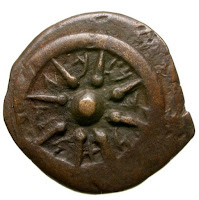In the New Testament Gospels of Luke and Mark is one of the famous passages of the Bible that is known as ''the lesson of the widow's mite''. It is about a poor widow who offered two small copper coins in a church's offering, while others made larger offerings. When Jesus observed this at the Temple in Jerusalem, he said (according to Luke) : ''Truly I tell you, this poor widow has put in more than all of them. For they all contributed out of their abundance, but she out of her poverty put in all she had to live on''
The Widow's mite with the star with eight rays on one side
However, the bronze coins were not described, leaving it to scholars to try and ascertain what coins were offered by the widow. They are generally believed to be ''lepton'' coins minted by Alexander Jannaeus, King of Judea from 103 to 76 BC. Two lepta were equal to a quadrans, the smallest Roman coin, and a lepton was the least valuable coin that circulated in Judea.
''The Widow's Mite'' painting by After Gustav Dore, 1880 AD
The term ''mite'' as is used nowadays was not existing at that time, when these coins were circulated. ''Mite'' came into use in the 14th century in Flanders, and means ''small cut piece'' in Old Dutch. It is also used in the King James Bible, which brought out the story of the widow's mite in 1611 AD.
During the times of King Alexander Jannaeus, many small bronze coins were issued, but the most commonly featured coin had an anchor and a star, Coins with ''anchors'' were among the first struck after Jews were granted authority to issue their own coins by the authorities, and they continued to be minted for the next century.
A lepton was equal to half of a prutah. Lepta were about the same diameter as prutot (plural for prutah) but were thinner and weighed half of it. During the Maccabean period, the Greek silver drachma is believed to have been valued at 336 lepta or 168 prutot, while a Roman denarius was about 96 prutot.
Of the prutot and lepta issued by Alexander Jannaeus, the most common ones had on their obverse an anchor and ''King Alexander'' in Greek, while the reverse had a star with eight rays and sometimes Hebrew letters between the rays or around the rim. They were however struck about a century before they were offered by the widow.
Widow's Mite, 103-76BC, weight 2.2 gm, diameter 15.1 mm, with Obverse having star of eight rays and Reverse has an anchor
The coin referred to in the ''lesson of the widow's mite'' is generally considered to be a lepton, the smallest and least valuable coin in circulation in Judea.




No comments:
Post a Comment
Any inputs or feedback is welcome!